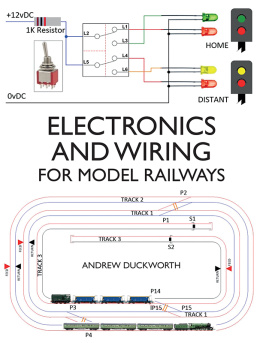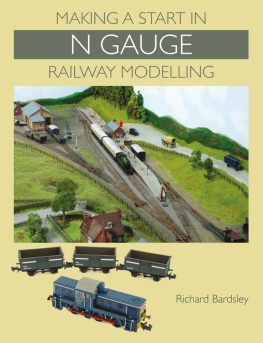
To complement this night scene, the First Great Western DMU model, retailed by Dapol, is fitted with an optional carriage lighting kit.
BUILDING A FOLDING
Model Railway Layout
A COMPREHENSIVE GUIDE
BUILDING A FOLDING
Model Railway Layout
A COMPREHENSIVE GUIDE
GRAHAM GOODCHILD

THE CROWOOD PRESS
First published in 2016 by
The Crowood Press Ltd
Ramsbury, Marlborough
Wiltshire SN8 2HR
www.crowood.com
This e-book first published in 2016
Graham Goodchild 2016
All rights reserved. No part of this publication may be reproduced or transmitted in any form or by any means, electronic or mechanical, including photocopy, recording, or any information storage and retrieval system, without permission in writing from the publishers.
British Library Cataloguing-in-Publication Data
A catalogue record for this book is available from the British Library.
ISBN 978 1 78500 200 7
Disclaimer
The author and the publisher do not accept any responsibility in any manner whatsoever for any error or omission, or any loss, damage, injury, adverse outcome, or liability of any kind incurred as a result of the use of any of the information contained in this book, or reliance upon it. If in doubt about any aspect of railway modelling readers are advised to seek professional advice.
Dedication
For Lily and Eleanor
Acknowledgements
My thanks go to the Technical Advice Bureau at Peco for their help in providing information on track wiring for the layout featured in this book. Also, thank you to Expressway Models, South Devon Railway for allowing me to photograph their model railway items. I am also indebted to the many feature writers, editors and contributors of various model railway magazines who have given me inspiration to build my own layout. Last, but certainly not least, a big thank you to my family and friends for their interest and support throughout the construction of the featured layout and during the writing of this book.
CONTENTS
INTRODUCTION
My interest in designing and constructing working models, including radio-controlled models, spans more than sixty years and started at a tender age with the gift of a penknife. Many a happy hour was spent whittling away at any old piece of scrap wood I could find, usually resulting in some sort of model boat of dubious description.
For one reason or another, model trains have not been one of my modelling priorities. Indeed, up to recently, my only experience of model trains had been a Triang train set received as a boy one Christmas. I remember that I would delight in seeing how fast I could make the train take a curve before it parted company with the track and the locomotive, predictably, coming to grief against a chair leg or some other item of household furniture. I now look back in horror at my disrespectful treatment of this once pristine model railway.
Now living near a main-line railway, I would sometimes stop on my way into town and watch the trains go by. The sight and sound of the Intercity diesels thundering past inspired me to build myself a proper model railway that would enable me to sit back and watch the trains go by and perhaps be entertained by incorporating some additional working features within the layout.

Fig. 1 The folding layout Teignside Quay.
I think one of the reasons why I didnt venture into model railways until recently was space, or rather the lack of it. Modern houses are not always over-generous in size and so a train layout sometimes cannot be out on permanent display. Also, the layout had to be large enough to accommodate one or more oval tracks for the continuous running of trains. It was this that led me to believe that what I required was a layout that could be folded and stored away when not in use. Traditionally a type of fibreboard is used for the base of layouts. However, as the folding layout needed to be portable, and in order to reduce weight, I decided that lightweight foam should be used for the base and the landscaping.
This comprehensive guide shows, with instructions, photographs and diagrams, how to construct a complete portable tabletop or stand-alone folding layout from timber and lightweight materials, such as foam. It also describes the techniques used in its construction. Most of the techniques considered in this book can equally be applied to other model railway layouts and scales. The base of the featured layout has sides and folds in half in a similar way to a large suitcase, thus keeping dirt and dust out (which can be a real nuisance with small-scale models) and, importantly, protecting the layout when stored away.
The featured layout is constructed to N-gauge scale and can accommodate up to three trains running simultaneously on tracks that run under and over hills surrounding a central water feature with boats moored to the quayside and paddle-boarders in action. Working features include a cable car and rolling road, together with a childrens roundabout and a helicopter with rotating blades. Construction details are described for these, including making street lighting, lighting for buildings and vehicles using LEDs and fibre optics for special effects. This book also describes what tools and adhesives are required, materials and their use, how to lay the track, wiring and landscaping.
It is intended that this book will appeal not only to modellers who wish to build the featured layout, but also will provide ideas for designing and building your own layout.
CHAPTER ONE
FIRST THOUGHTS
RESEARCH
Not having built what I would call a proper model railway before, I was unsure where I should start. In hindsight it would have been advantageous if I had joined my local model railway club, where no doubt I would have been put on the right track and also would have gained some valuable experience.
It was only by chance upon visiting a heritage railway, in the model shop located within the train station, that I came across some small model locomotives and carriages. These locomotives were half the size of the OO-scale trains that I had been previously accustomed to as a youngster. I learned that these small locomotives were in fact N-gauge scale; apparently N-gauge model railways have been around for more than forty years. I certainly had a lot of catching up to do regarding the availability of products and it was also going to be a steep learning curve in the construction of a model railway layout.

Fig. 2 Online research and gleaning information from magazines on the world of model railways is a good place to start when deciding on the type of layout to build.
My local newsagent was my first port of call in my quest for what magazines had to offer on model railways, and certainly seeing the number of different titles seemed to testify to the popularity of the subject. I came away with a handful of magazines to take home and study, the majority of which helpfully show how to make various layout features. Also, the advertisements in the magazines are a helpful source of products that are available to the railway modeller. Going online and trawling through the seemingly endless websites is also a great source of information for everything on the subject; this eventually pointed me in the right direction on the kind of layout that I wanted to build.
Next page
















